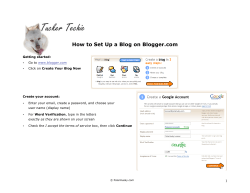
Starting and Maintaining a Blog FREEDOM OF EXPRESSION
Embassy of the United States of America FREEDOM OF EXPRESSION Starting and Maintaining a Blog T he Internet and social media have transformed the way people create, discover and share information. People have transitioned from being mere consumers of information to being creators of content. Blogs are at the forefront of this transformation. Blogging enables anyone with a computer and an Internet connection to share their thoughts with the world. Let’s take a look at the steps needed to start and maintain a blog. From political to satirical, blogs enable anyone with a computer and an internet connection to share their opinion. © AP Images Establish Your Goal To begin, think about why you want to start a blog. • Is your goal to share news about your local community? that interest them. Politics, sports, entertainment, technology and business are all popular topics. While these broad subjects are a great place to start, most successful blogs drill down even further • A re you an aspiring photographer looking to display your work? into a specific topic, or niche. • A re you an expert on a certain topic? ing the latest Android-based tab- Then, think about the audience you want to reach and the topics For example, instead of technology, your blog might focus on reviewlets. Instead of business, your niche might be writing about medical technology startups. Starting and Maintaining a Blog TIPS FOR BUILDING AN AUDIENCE: • Be media savvy. Give readers more than just words on a screen. Try embedding other forms of media to support your writing, including big, bold photos, engaging video, tweets and infographics. • Get social. Promoting your blog on social media sites allows your content to be distributed through your readers’ extended networks. • Post lists. Articles such as “Top 10 Ways to Travel on a Budget” are still around because they work. People love quick, bite-sized content. • Connect with people. Reach out to key influencers in your niche and get to know them, and don’t forget to connect with people at conferences and events — yes, in real life. • Create great content. There’s no replacement for hard work and simply creating content that people want to read and share. As comedian Steve Martin once said, “Be so good they can’t ignore you.” Giving readers something to see as well as read helps build an audience. antonemus/Flickr Set Up Your Blog The next step is to think about the platform, design and name of your blog. Technology is always changing, so while some people simply use Twitter as a 140-character microblog and others use Tumblr to quickly post photos, links and videos, most people think of a blog as a website that allows you to write and share posts on a regular basis. you can purchase from third-party vendors to match your style. If you want a unique look, hire a graphic designer to create your site. There are several free platforms that allow you to get started in minutes, while many advanced users pay a hosting company so that they can control their blog’s format and features a bit more. No matter which way you go, here are two key tips: First, match the look and feel of your site to your topic. For example, a blog covering celebrity gossip might use bold colors and large, in-your-face headlines, while a site about eco-friendly materials and sustainability might be more subtle and use green tones. Second, optimize for mobile. No longer is having a blog that looks good on mobile devices nice to have, it’s mandatory for anyone starting a new site. In terms of design, most services have basic templates to get you started, and there are thousands of themes Now it’s time to name your blog. While the perfect blog name is as much art as it is science, here are some Starting and Maintaining a Blog quick tips: First, make it easy to remember, easy to say and easy to spell. Second, avoid numbers, dashes and underscores. Third, don’t use brand names or trademarks of other products or companies. Choose Your Format For many, a blog serves as an online diary, a place to share what’s on your mind. However, it can be helpful to your readers if you structure your posts to match the type of content you are blogging. For example: •News: If you are reporting on events, assume the role of journalist and be as objective as possible to establish your blog as a credible source. •Interview: If you are interviewing someone, post the interview in a question-and-answer format. •How-To: If you want to teach your readers how to create or do something, structure your blog post with brief bullet points (like the how-to steps you are reading here). •Travel: If you want to share your impressions of interesting locations, share the sights and sounds of your travels with your reader. •Reviews: If you want to share your opinions of new products or creative works, give your honest opinion and invite readers to share their opinions, too. Determine Your Frequency Once you’ve chosen a format, determine how often you’ll publish. Once per day? Twice per week? Every Thursday at 9 a.m.? Posting to your blog on a regular schedule helps your audience know when to check for new posts. Many times your topic will determine your schedule. For example, if you’re covering sports, you might post after every basketball game of the team you are following. If you’re covering politics, it could be several times per month for most of the year, but change to multiple posts per day surrounding an important election. Reviewing new products such as mobile phones is a popular blogging format. © AP Images Starting and Maintaining a Blog Find Your Voice If a reader of your blog were to close their eyes and picture you speaking directly to them, how would they describe you? The “voice” of your blog is the unique style and energy that only you bring to the table. Sometimes you have it from day one, and sometimes it evolves in your writing over time. Are you the fashion authority, confidently telling your readers what the hot new trends will be? Perhaps you’re the voice of the average citizen, reporting how government policy is affecting your town. Or maybe you’re an enthusiastic traveler eager to share the excitement of new experiences. The choice is yours. Final Caveats and Advice •It’s not about the money. While a blog can serve as a launching point to other ventures (speaking appearances, book deals, consulting work), it’s best not to expect to make money from blogging. •Consistency is key. Blogging isn’t easy — 95 percent of blogs end up abandoned. Posting to your blog on a regular schedule and with a consistent voice will help you attract and keep readers. everyone will agree with your opinion, but inspiring a lively discussion means you’ve struck a chord. •Just do it. Many people wait until everything is perfect before they launch their blog, and thus never end up doing it. Don’t wait another day. Get your blog started today and let your voice be heard. This pamphlet was produced in conjunction with a popular New York City blogger. •Have a thick skin. If you’re going to allow readers to post comments on your blog, be prepared to deal with disagreement and extreme views. Not Posting to your blog on a regular schedule and with a consistent voice is vital. © AP Images Published February 2014 ISBN 978–1–625–92197–0 U N I T E D S TAT E S D E PA RT M E N T O F S TAT E B U R E A U O F I N T E R N AT I O N A L I N F O R M AT I O N P R O G R A M S
© Copyright 2025





















